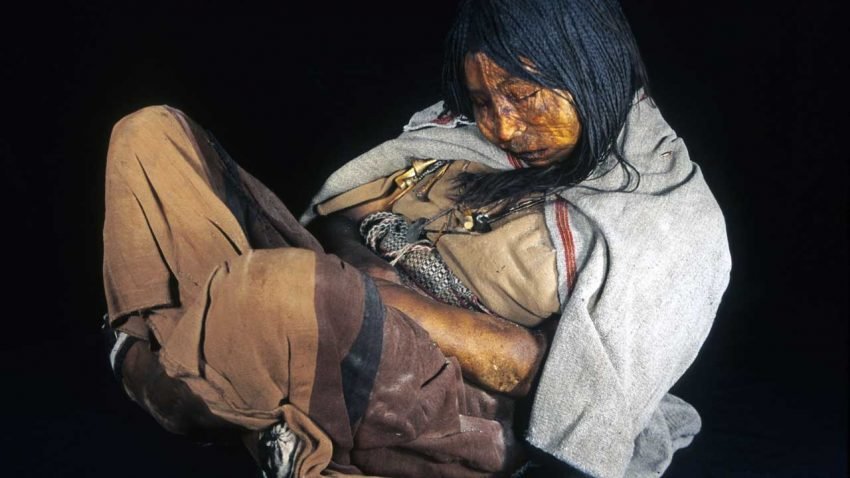
"[The study] is confirming a picture that has been emerging" about how and when the first people arrived in the Americas, says Jon Erlandson, an archaeologist at the University of Oregon in Eugene who wasn't involved in the research. "It challenges archaeologists to catch up with the genomics people, because they're creating models for us that need to be tested."
At the heart of the new research is a unique dataset: 92 skeletons and mummies, mostly from the western part of South America. These individuals lived between 8600 to 500 years ago in regions ranging from Mexico to Chile. A team of researchers sequenced each sample's mitochondrial genome, or the genes found in the power plants of a person's cells. Mitochondrial genes are passed down directly from mother to offspring, so the sequences open a window onto the matrilineal heritage of indigenous Americans extending all the way back to their roots in Siberia.
By tallying up the random mutations that accumulate in populations that have been separated, geneticists can count backwards and figure out when two groups last had a common ancestor. When the researchers applied that technique to the 92 mummies and skeletons, they found that their ancestors had last been in contact with Siberian populations about 23,000 years ago. After that, a group with about 2000 child-bearing females (perhaps about 10,000 people total) spent 6000 years or so genetically cut off from other groups of humans. That supports the idea that the ancestors of the earliest Americans spent a few millennia stranded in Beringia, the now submerged landmass that once stretched from Siberia to Alaska, before the ice sheets started to melt and open up passages to the New World.
Then, 16,000 years ago, the population boomed, with many different lineages suddenly branching off from one another. The researchers believe that represents the moment at which people were first able to move out of Beringia and into the Americas, where a host of new land and resources allowed the population to grow and spread out rapidly. At that point in time, "the route can only be along the Pacific coast," says Alan Cooper, an evolutionary biologist at the University of Adelaide in Australia who helped lead the study. "The ice sheets are still so thick at that point that there's no way through [farther inland]."
If you're hopping down coasts by boat, "then you can actually move relatively fast," says Theodore Schurr, an anthropological geneticist at the University of Pennsylvania who wasn't involved in the study. That method could help explain how people spread south so quickly. Archaeological evidence shows that Monte Verde in southern Chile was occupied about 14,500 years ago. "That's 1500 years to cover the entire continent," Cooper says.
But it was what happened next that really surprised him: Everybody settled down. Within a few thousand years, many of the ancient lineages had already diverged from one another, meaning that people from one group were not having babies with people from another (or at least, their mothers weren't moving around, since we're talking about mitochondrial DNA). The team found 84 separate genetic lineages represented by the 92 samples, they report today inScience Advances.
That structure stayed in place until the cataclysm that was European contact. The researchers didn't have to do any fancy modeling to understand just how severe the population collapse was. None of the 84 lineages they found are even traceable past contact because not a single living person who belongs to any of them has been found. "When Europeans arrived, some of those populations were wiped out completely," says Bastien Llamas, a geneticist also at the University of Adelaide and first author of the new study.
Of course, present-day populations in South America haven't been sampled very well, so it's possible that scientists will find descendants of some of the supposedly lost lineages as they collect more genetic samples from living people. "You just have to sequence the right group in order to find a [mitochondrial] genome that might be rare in other geographic regions," says Ripan Malhi, a geneticist at the University of Illinois, Urbana-Champaign, who wasn't involved in the study. "But I do think it's likely true that there is this large population decline and loss of [mitochondrial] genome diversity after contact."
Llamas knows that his team doesn't yet have the full picture of genetic diversity in the Americas. With mitochondrial DNA, "we only see one part of the story"—the mother-to-child line. "You don't see what happened with men, you don't even see what happened with all women"—only the ones who had children, Schurr agrees.
Still, the team's predictions line up well enough with archaeological evidence and previous genomic studies that many scientists suspect the view from mitochondrial DNA's narrow window is largely accurate. "The literature is full of examples where demographic models predicted using mitochondrial DNA were later corroborated by large-scale genomic analysis," notes Antonio Salas, a human geneticist at the University of Santiago de Compostela in Spain, who has also studied the mitochondrial genomes of ancient South Americans. Cooper and Llamas already have some whole genomes in hand and expect to continue sequencing their unique set of samples.
But in order to truly understand the effect of European contact and its aftermath, Malhi says, scientists have to see which genetic lineages made it through. That means sampling many more living people—and making research about their history meaningful and accessible to them. "The worst case scenario for me," Malhi says, "would be to generate this amazing genetic map and history of indigenous peoples of the Americas with no involvement or community engagement with living indigenous populations."



Reader Comments
to our Newsletter